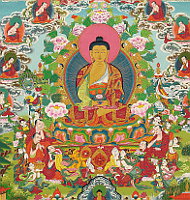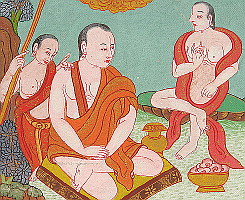| < Prev | Next > |
|---|
 Most books or articles about Buddhism are rather complicated and confusing. However the essence of Buddhism can be explained on one page. The Dalai Lama himself is a master in bringing the essentials of Buddhism to the point. Famous are his sayings like "The purpose of life is to be happy." or "One should help others. And if you cannot help them, at least do not hurt them".
Most books or articles about Buddhism are rather complicated and confusing. However the essence of Buddhism can be explained on one page. The Dalai Lama himself is a master in bringing the essentials of Buddhism to the point. Famous are his sayings like "The purpose of life is to be happy." or "One should help others. And if you cannot help them, at least do not hurt them".
The Historical Buddha
The historical Buddha - also known as Gautama Buddha or Siddharta Buddha or Shakyamuni Buddha - was born circa 563-483 BC, presumably in Lumbini, Nepal, as a prince of rich parents shielded off from the real, ugly world by high palace walls. One day he left his golden cage and recognized that the world outside the walls of his parents' luxurious estate was a different one full of hardships.
Suffering as the Cause of Evil
 Buddha saw the suffering of people. From then on he spent the rest of his life to find the causes of suffering and to teach how to overcome it. By suffering Buddhists understand not only physical pain and hardship but also the suffering because they are unhappy or have anxieties.
Buddha saw the suffering of people. From then on he spent the rest of his life to find the causes of suffering and to teach how to overcome it. By suffering Buddhists understand not only physical pain and hardship but also the suffering because they are unhappy or have anxieties.
The Three Poisons
According to Buddha, the reasons for suffering are "The Three Poisons". These are:
- Attachment or Desire.
- Ignorance.
- Hatred.
These three poisons produce permanent fighting with other human beings, and thus reproduce suffering.
Enlightenment
 According to Buddhist belief the "Three Poisons", and thus the reasons for all suffering in this world, can be overcome by what the Tibetans call "Sangya". There are two words in it, "sang" and "gya". "Sang" means to get rid of the three poisons, and "gya" stands for complete knowledge of everything. This "knowing", understanding the world, is what Buddhists call enlightenment.
According to Buddhist belief the "Three Poisons", and thus the reasons for all suffering in this world, can be overcome by what the Tibetans call "Sangya". There are two words in it, "sang" and "gya". "Sang" means to get rid of the three poisons, and "gya" stands for complete knowledge of everything. This "knowing", understanding the world, is what Buddhists call enlightenment.
Compassion
The way to achieve enlightenment is mainly by exerting compassion. Compassion means to be kind to all beings, humans as well as animals. Compassion means to help others, being focused on the betterment of others, not doing any evil to others. And by exerting compassion one's mind becomes stronger.
The Four Noble Truths
 The central theory of suffering and how to overcome it, is wrapped up in the Four Noble Truths. These are:
The central theory of suffering and how to overcome it, is wrapped up in the Four Noble Truths. These are:
- There is suffering in the world.
- The reasons for suffering are the 'Three Poisons'.
- There is a way to end suffering.
- The way out is to follow the "Eightfold Path".
The Noble Eightfold Path
The "Noble Eightfold Path" is the practical guidebook for a Buddhist. Following the Eightfold Path is the way to end suffering. The Eightfold Path is:
- Right Understanding.
- Right Thoughts.
- Right Speech.
- Right Action.
- Right Livelihood.
- Right Effort.
- Right Mindfulness.
- Right Concentration.
Karma
 Buddhism does not know an ultimate God as Christianity or the Jewish or Islam religions do. Therefore it makes no sense to hope that some kind of supernatural power (God) will come for your support. Nor is your destiny defined by an all-mighty God in advance. Only you as an individual are responsible for your destiny and how you impact the world. All results come out of your actions, your own behavior. Good actions will result in good results, and vice versa.
Buddhism does not know an ultimate God as Christianity or the Jewish or Islam religions do. Therefore it makes no sense to hope that some kind of supernatural power (God) will come for your support. Nor is your destiny defined by an all-mighty God in advance. Only you as an individual are responsible for your destiny and how you impact the world. All results come out of your actions, your own behavior. Good actions will result in good results, and vice versa.
The Concept of Rebirths
Buddhism believes in the rebirth of all beings, including humans, animals and even supernatural beings like the Buddhist "gods" and "semi-gods".
The Buddhist Concept of Heaven and Hell
There are 6 levels of heaven and hell. Each level has a different quality - from a quite pleasant place on top of the rating down to something that you would like to avoid by all means, a condition where humans are tormented in a most gruesome way by ugly demons. After one's death each being will be transformed to one of these levels. To which level, well that depends on how you behave in your current life.
Nirvana
 The cycle of rebirths is part of the mechanism of suffering. But one can end the cycle by total enlightenment. This ultimate condition is called "Nirvana". Those who reach Nirvana, become Buddhas. This explains why there are more Buddhas in the Buddhist pantheon than just the historical Buddha Gautama. There have been many Buddhas before him and many more will continue to come in the future.
The cycle of rebirths is part of the mechanism of suffering. But one can end the cycle by total enlightenment. This ultimate condition is called "Nirvana". Those who reach Nirvana, become Buddhas. This explains why there are more Buddhas in the Buddhist pantheon than just the historical Buddha Gautama. There have been many Buddhas before him and many more will continue to come in the future.
Dieter Wanczura, April 2010







